Elementary finance
Difference between accounting and finance
In this course in elementary finance, we shall study investments, and the basic technique called "discounting", or "discounting cash flow analysis" (DCF).
The address of the course is https://lapasserelle.com/finance
It is the continuation of the course in general accounting at https://lapasserelle.com/accounting
The main difference between accounting and finance concerns time. Time plays a more sophisticated role in finance than in accounting.
In the accounting course we saw that accounting is a set of techniques to record, organise and present in a useful manner monetary information about the activity of the firm. This information, properly organised, and properly presented in a synthetic way, is very useful to managers. (All the relevant information is already contained in the journal, but it is not displayed in a synthetic, useful form.)
What makes accounting somewhat complicated to beginners is that we measure not only movements of cash but also movements of value of different kinds (and therefore we keep track of several different accounts). Double-entry accounting - you will remember - is value accounting, as opposed to the rudimentary accounting we do in the booklet of our checkbook, which is only cash accounting.
In accounting we meet time when we deal with IOU's and when we prepare budgets. But its role is rather simple. Budgets are a chapter of cost accounting, itself a development of general accounting into more details.
It is a promise given to us by somebody else, usually as a payment in some transaction, promising to pay us a certain amount of money, say 20 000 €, at some future date, say in 45 days.
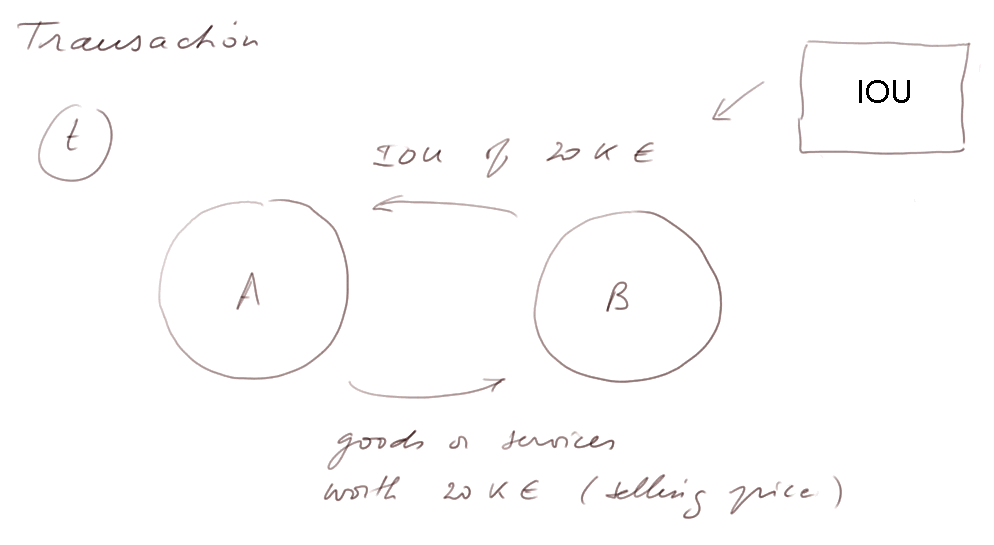
Here is what the IOU may look like:
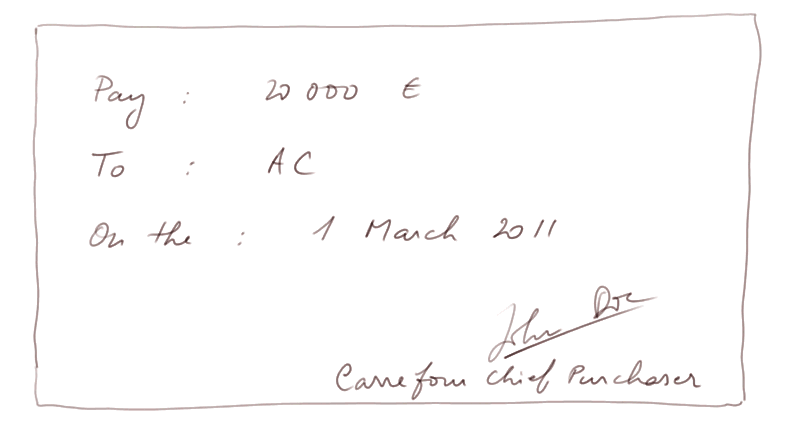
This IOU is not 20 000€ in cash, yet, in accounting, we record it, in our accounting system, as an asset worth 20 000€.
The posting of the transaction in which we received this IOU as a payment for a sale, is:
- Debtors account: debit 20K€
- Sales account: credit 20K€
And the IOU ends up as an asset in the balance sheet of our firm:
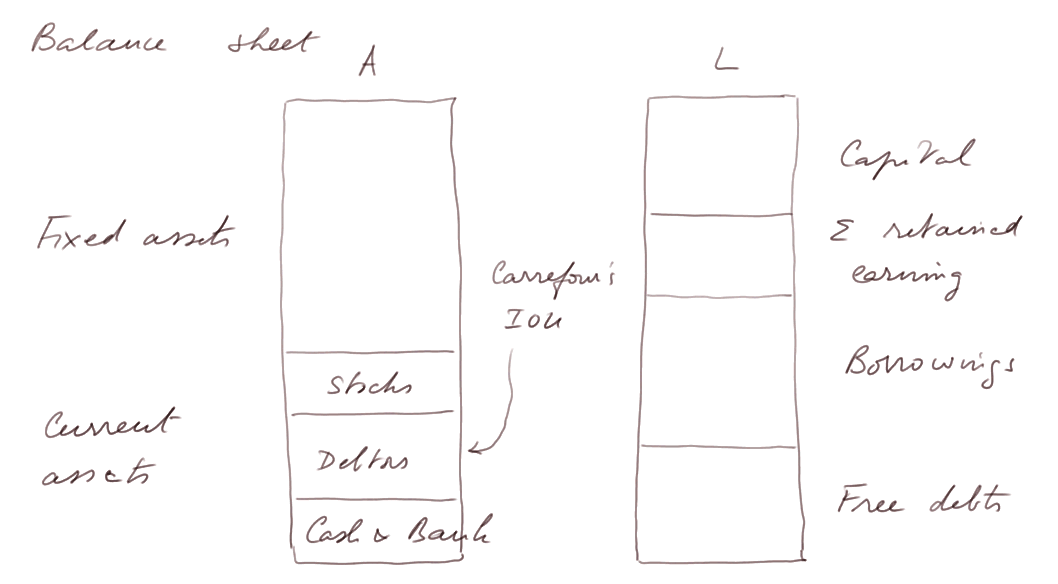
Readers who are not yet at ease with these ideas should go back to the general accounting course.
Remember also that the asset side of a balance sheet is a list of assets recorded "at their value to us":
- when this value varies over time, the figure in the balance sheet is the "historical cost" we paid at the time of acquisition
- the list of assets is rather heterogeneous and crude
- the total of the assets is not the value of the firm (even if the firm has no external debts), whether to us or to anyone
In finance, we introduce a new concept: the IOU of the above example has a value today.
- It is not 20 000€
- It is less. Indeed everyone prefers 20K€ in cash, to 20K€ as a promise of payment of cash in 1 month 1/2.
Value today, also called "present value". This is a fundamental concept in finance: the present value of a cash flow to be received at a certain date in the future is the value today of the piece of paper promising this future cash flow. It is the price someone today should be willing to pay for the promise of this future sum of money.
We shall learn how to compute the present value of a future cash flow. Right now let's try and understand this basic idea, without learning yet the techniques to figure out the present value.
It underlies such expressions as:
- "a dollar today is worth more than a dollar tomorrow", or
- "finance looks at the time value of money"
both of which, in the teacher's view, sound certainly very intelligent, but are rather enigmatic, incomprehensible, obscure, perplexing, and vague, without proper explanations.
When considering an economic agent A (usually us), we shall represent his cash flows on a time line as this:
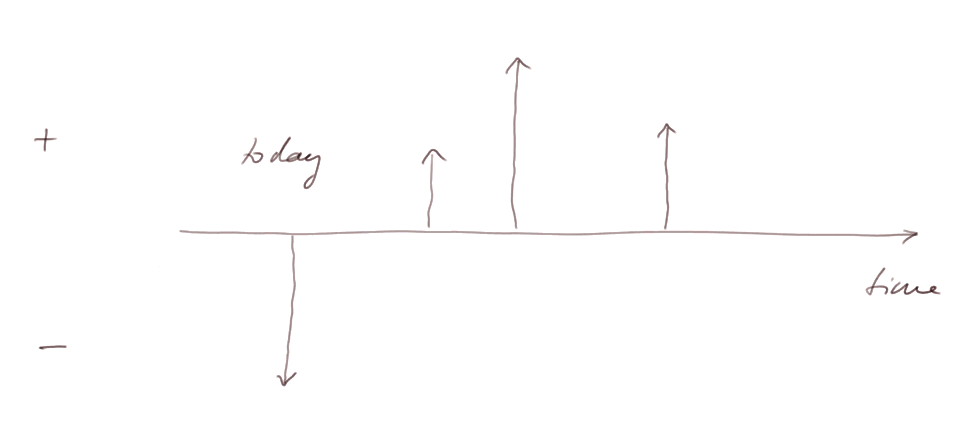
Arrows pointing downward represent cash flows leaving our purse (cash outlays), and arrows pointing upward represent cash flows arriving into our purse (cash inflows). There may be arrows pointing downward after some pointing upward. And the stream may begin with an arrow pointing up.
Every future cash flow, as we said, will have a value today :
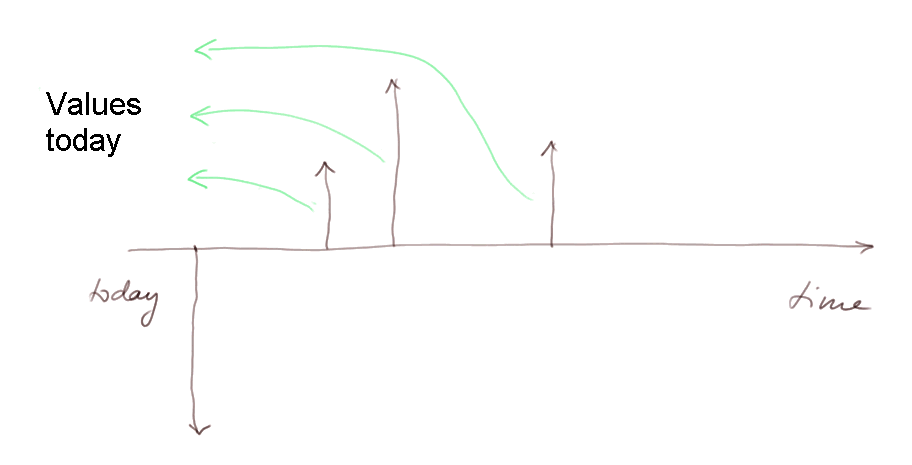
and the sum of all the present values of the future cash flows minus the initial cash flow (that was, for instance, necessary to produce the future ones) will be called the Net Present Value of the stream of cash flows.
In finance, another fundamental concept (which we have begun to introduce above) is that of investment.
An investment is the setting aside of some value (that we could consume today) to employ it to produce future values.
It is represented as we have already done. The investment is the set of all these cash flows: the initial one (to produce future cash flows) and the future ones.
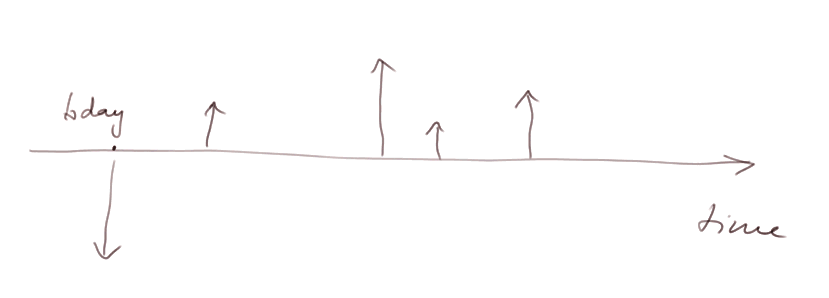
We shall devote next lesson to a general description of investments, but let's see already some aspects of the concept.
The notion of investment comes even before money. Humankind began to invest, in neolithic times, when farmers set aside a part of their harvest to plant the next crop.
NPVs of investments.
An investment will have a net present value (NPV), which we shall learn how to compute.
- In some cases, the sum of the values today of the future cash flows of an investment will be equal to the value invested today (the initial cash flow pointing downward). In those cases NPV = 0
- In some other cases, we will be able to invest today a value which will produce future cash flows (abbreviated, CFs) the sum of the present values of which will be more than the initial value. Then NPV > 0
There will also exist contemplated investments where NPV < 0, but these of course will be discarded.
To summarize, finance will be concerned with
- evaluating,
- comparing,
- and selecting
investments.
Screens of the video
|
|
|
screen number display zone |
Course table of contents
Contact